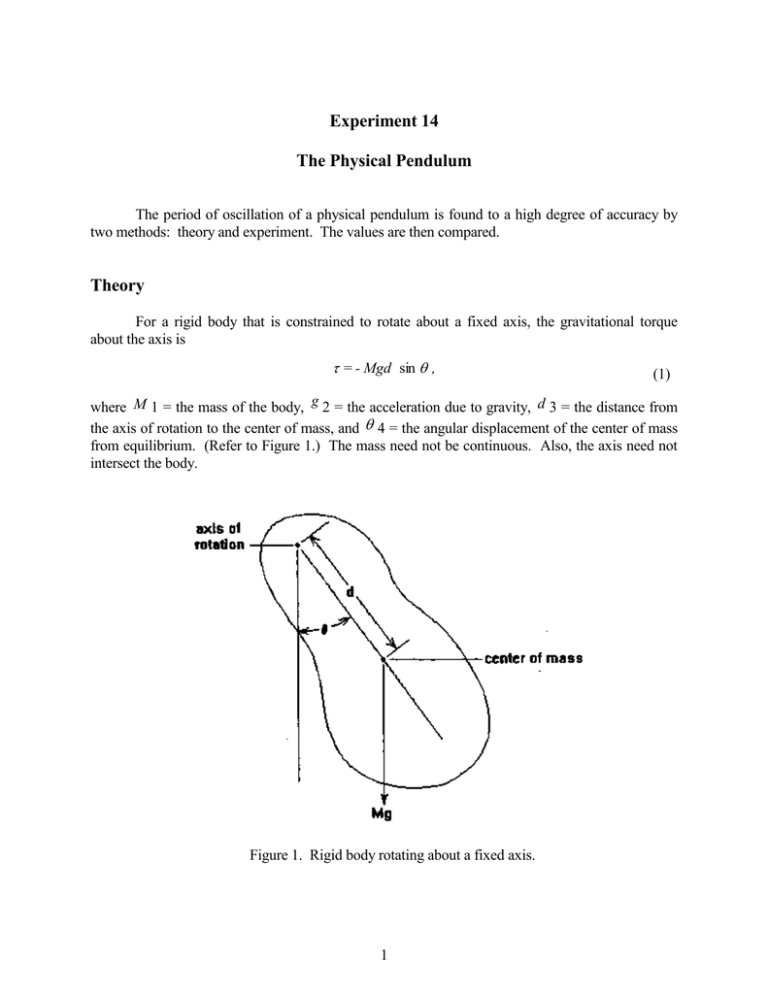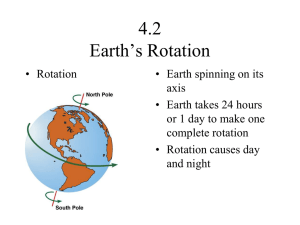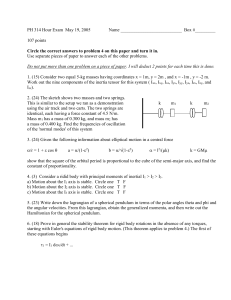Experiment 14 The Physical Pendulum
advertisement

Experiment 14 The Physical Pendulum The period of oscillation of a physical pendulum is found to a high degree of accuracy by two methods: theory and experiment. The values are then compared. Theory For a rigid body that is constrained to rotate about a fixed axis, the gravitational torque about the axis is = - Mgd sin , (1) where M 1 = the mass of the body, g 2 = the acceleration due to gravity, d 3 = the distance from the axis of rotation to the center of mass, and 4 = the angular displacement of the center of mass from equilibrium. (Refer to Figure 1.) The mass need not be continuous. Also, the axis need not intersect the body. Figure 1. Rigid body rotating about a fixed axis. 1 The torque produces an angular acceleration according to the rotational version of Newton's Second Law: 2 =I=I d 2 , dt (2) where I 5 = the moment of inertia of the body about the axis of rotation. Eliminating 6 in (1) and (2), the result is d + Mgd sin = 0 . d t2 I 2 (3) For sufficiently small oscillations about the equilibrium position (an angular displacement of 7 7 causes an error of less than 0.1%), sin 8 may be replaced by 9 (assuming 10 is expressed in radians). Hence, (3) becomes the differential equation that describes simple harmonic motion: d + 2 =0 , d t2 2 where the angular frequency of oscillation is = Mgd , I which is measured in radians per second. The frequency, which is measured in cycles per second, or hertz, is thus f= 1 2 Mgd , I since one cycle corresponds to 2 11 radians. The period is therefore I . Mgd T = 2 (4) 2 This formula can be checked for the special case of a simple pendulum, for which I = M d 12. In this case (4) yields T = 2 d , g (5) which is the correct result. Equation (4) holds for any rigid body. In the experiment all of the bodies have uniform 2 mass density. In this case T 13 and d 14 are independent of the value of density. Hence, M 15, d 16, and I 17 can be determined using an unknown density; this quantity will cancel when the expressions for M 18, d 19, and I 20 are substituted into (4). According to the particular body, it may be convenient not to use the volume density defined as = mass , volume but rather the areal density, defined as = mass , area = mass . length or the linear density, defined as Apparatus o physical pendulum o table clamp and upright o meter stick, vernier caliper, and/or ruler o knife edge o right-angle clamp o stopwatch Each group will use a different pendulum. The various pendulums are shown in Figures 2 and 3. Part I: Description Give a clear and precise description of the body and the axis of rotation. Because a high degree of accuracy is required, carefully perform all length measurements to the nearest fraction of a millimeter. Because the body is homogeneous, its mass need not be measured. (Refer to the Theory section.) Include a clearly labeled diagram that contains all relevant length measurements. 3 4 Figure 2. Physical pendulums shown with their various axes of rotation. The centers of mass can be determined by symmetry. 5 Part II: Theoretical Period Using the length measurements in Part I, determine the total mass, M 21, in terms of the unknown volume density, 22, areal density, 23, or linear density, 24. (Refer to the Theory section.) Determine the value of the distance, d 25, from the axis of rotation to the center of mass. In terms of the density that was chosen above, determine the moment of inertia, I 26, about the axis of rotation. Formulas for standard moments of inertia, together with the parallel-axis theorem and the plane-figure theorem, should be used. Show all calculations clearly and completely. State any approximations. Using (4) compute the theoretical period of oscillation. The result should have an uncertainty less than 0.5%. Part III: Experimental Period Accurately measure the period of oscillation for small amplitudes (less than 7 27). This can be accomplished by counting a large number of oscillation (between 50 and 100) and dividing the total time by the number of oscillations. Perform at least three trials. The three values should deviate from one another by less than 0.5%. Determine the average period. Clearly display the raw data and the calculations. Part IV: Results Clearly display together the theoretical and experimental values of the period of oscillation in a results table. Determine the percentage error. This should be less than roughly 0.5%. If the error is equal to or greater than 1%, at least one mistake has been made. Check the measurements and the calculations. Locate and eliminate the error(s). Questions 1) If the amplitude is large, will the resultant period be greater than, less than, or equal to the period for small amplitudes? Explain. 2) In general, if the entire mass of a physical pendulum is imagined to be moved to the center of mass, will the period of this simple pendulum be greater than, less than, or equal to the original period? Explain. 3) In general, if the entire mass of a physical pendulum is imagined to be moved to a position equal to the radius of gyration away from the axis of rotation, will the period of this simple pendulum be greater than, less than, or equal to the original period? Explain. 6



